For snowy regions, you’ll find several evergreens that make excellent privacy hedges. American Arborvitae, Emerald Green Arborvitae, and Green Giant Arborvitae all support heavy snow loads with their strong frameworks. Cold-hardy boxwoods, upright junipers like Blue Arrow and Skyrocket, American Holly, and Yews also perform exceptionally well. Canadian Hemlock and Norway Spruce provide substantial barriers while naturally shedding snow. The right spacing and minimal winter maintenance guarantee these hedges maintain their privacy function year-round.
Arborvitae Varieties for Snowy Regions
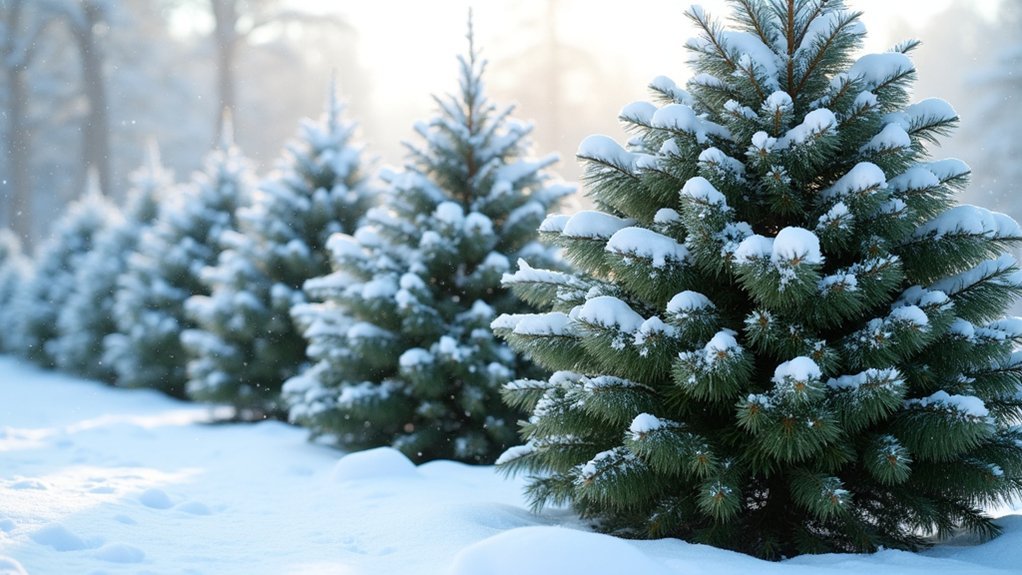
When considering privacy hedges for snowy regions, Arborvitae stands out as an exceptional choice due to its resilient characteristics. The American Arborvitae (Thuja occidentalis) excels in areas with heavy snowfall, as its dense foliage can support substantial snow loads without breaking.
For smaller spaces, Emerald Green Arborvitae offers year-round bright coloration with a compact, upright form that’s perfect for creating a tight privacy hedge while effectively blocking wind and snow.
If you’re looking for rapid growth, the Green Giant variety reaches impressive heights of up to 60 feet and resists common pests while handling snowy conditions admirably.
You’ll appreciate how Arborvitae’s thick growth not only guarantees privacy but also acts as a snow barrier, preventing drifts across walkways and driveways.
These adaptable plants thrive in full sun and accommodate various soil types.
Cold-Hardy Boxwood Selections
Although many traditional hedges struggle in snowy climates, cold-hardy boxwood varieties offer exceptional privacy solutions for winter-heavy regions.
Green Mountain Boxwood stands out as a particularly resilient option for those seeking year-round screening in USDA Zones 4-8.
Green Mountain Boxwood delivers exceptional year-round privacy protection even in the harshest winter conditions across Zones 4-8.
This cold-hardy privacy hedge delivers several advantages:
- Maintains its rich evergreen foliage throughout winter, ensuring continuous privacy despite heavy snowfall.
- Grows steadily at 3 inches per year, developing into a dense screen that keeps your property secluded.
- Resists damage from deer and rabbits, eliminating common threats to hedge integrity.
- Performs well in both sunny and shaded locations, giving you flexibility in placement around your property.
Regular pruning will help your Green Mountain Boxwood maintain its ideal shape and screening density year-round.
Evergreen Juniper Options for Heavy Snow Loads
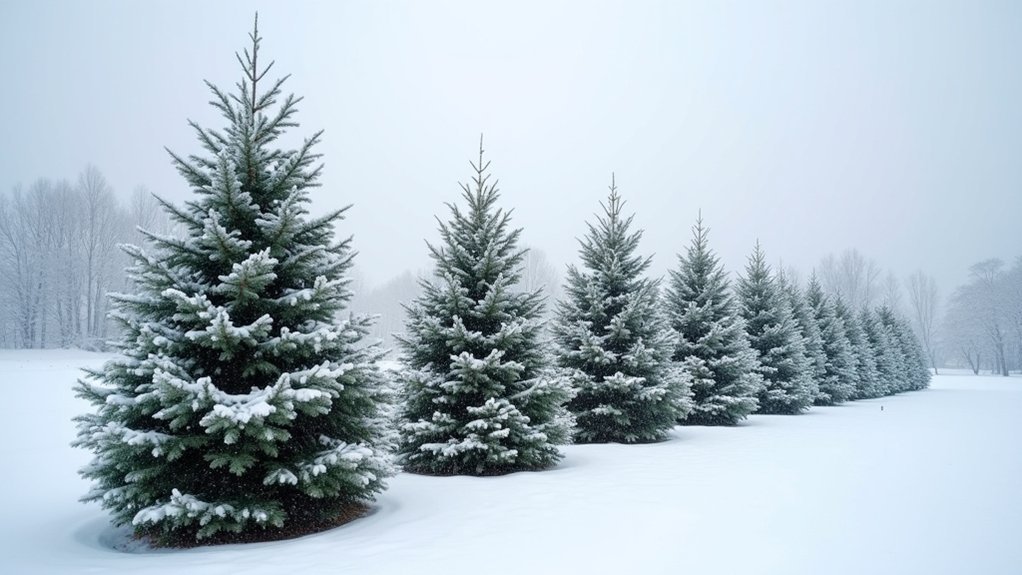
Juniper varieties like Blue Arrow and Wichita Blue offer exceptional structural integrity under heavy snow loads due to their narrow, upright growth habits.
You’ll find these evergreens particularly valuable as privacy screens that won’t collapse during winter storms, thanks to their compact needle-type foliage that sheds snow efficiently.
Their adaptability to various soil conditions and minimal maintenance requirements make junipers perfect for snowy regions where you need year-round screening that won’t buckle under the weight of accumulated precipitation.
Juniper Varieties Comparison
Among the most resilient evergreens for snowy climates, several juniper varieties stand out as exceptional privacy hedge options.
When selecting junipers for heavy snow regions, you’ll want to compare their specific strengths across hardiness zones 3-9.
- Blue Arrow Juniper – Features an extremely narrow, columnar shape that naturally sheds snow without branch breakage, perfect for tight spaces in your privacy hedge.
- Wichita Blue Juniper – Offers striking blue-green foliage with a broader pyramidal form that maintains structural integrity under snow loads.
- Skyrocket Juniper – Provides exceptional vertical growth with minimal spread, ideal for creating tall privacy screens in snow-prone areas.
- Taylor Juniper – Combines drought-resistant qualities with excellent snow tolerance, requiring minimal maintenance after winter storms.
Snow-Load Structural Considerations
Heavy snowfall poses unique challenges for privacy hedges, particularly when it comes to structural integrity. When selecting evergreen junipers for your privacy screen, their natural architecture offers significant advantages in snow-prone regions.
The Blue Arrow juniper’s upright, narrow form minimizes snow accumulation while maintaining an effective dense hedge barrier. You’ll find their needle-like foliage efficiently sheds snow, preventing branch breakage during winter storms.
| Juniper Feature | Snow-Load Benefit |
|---|---|
| Upright growth | Reduces surface area for snow accumulation |
| Dense foliage | Distributes weight more evenly |
| Narrow profile | Minimizes horizontal snow catchment |
| Flexible branches | Bends rather than breaks under pressure |
For maximum snow-load resistance, guarantee proper spacing between plantings. This allows adequate air circulation, which helps junipers dry quickly after snowfall, further reducing structural stress while maintaining privacy throughout winter months.
American Holly as a Snow-Resistant Privacy Screen
When seeking a privacy hedge that can withstand the harsh realities of winter, American Holly (Ilex opaca) stands out as an exceptional choice. This sturdy evergreen shrub creates a dense screen that reaches 15-30 feet tall and 5-20 feet wide, perfect for year-round privacy in snowy regions.
You’ll appreciate American Holly for:
- Its glossy dark green leaves that maintain vibrant color throughout harsh winters
- Bright red berries that attract birds while adding winter visual interest
- Exceptional resilience against heavy snow loads without branch breakage
- Minimal maintenance requirements once established
American Holly thrives in both full sun and partial shade, adapting well to acidic, well-drained soils.
You’ll find it’s drought-tolerant after establishment, making it a practical and beautiful solution for your winter privacy needs.
Yew Hedges That Stand Strong in Winter
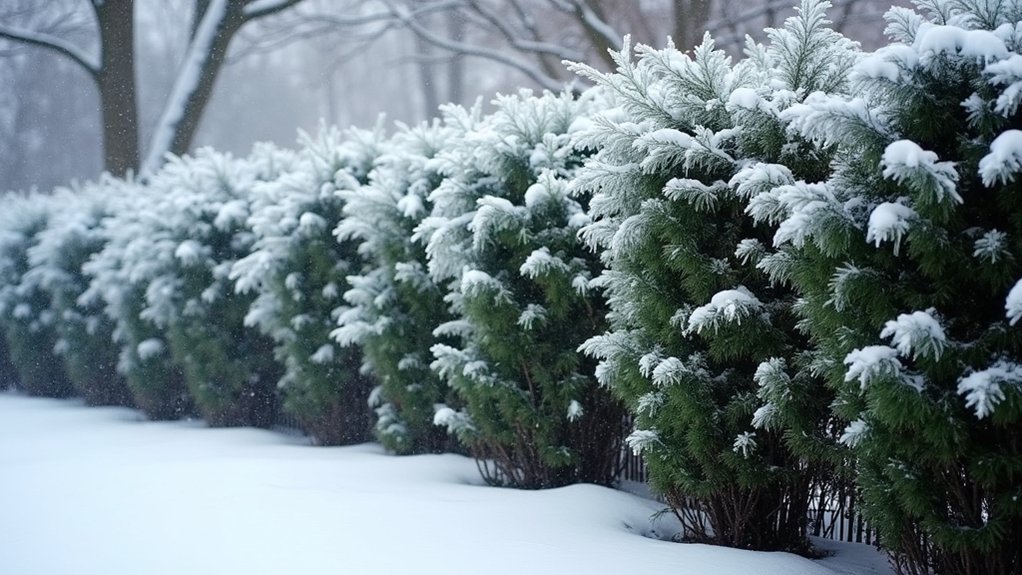
While American Holly offers remarkable winter resilience, Yew hedges (Taxus spp.) present another outstanding option for privacy screens in snowy regions. Their flexible branches can bend under heavy snow loads without breaking, making them exceptionally durable during harsh winter months.
You’ll appreciate that these evergreen shrubs maintain their glossy green needles year-round, ensuring your privacy screen remains effective even in the coldest winter temperatures. Thriving in USDA zones 4-8, yews adapt well to various soil conditions as long as drainage is good.
What makes yew hedges particularly attractive is their versatility—you can prune them into your preferred shape while maintaining their dense growth habit. The bright red fruits that appear in fall add visual interest to your winter landscape and attract birds, bringing life to your garden during dormant months.
Emerald Green Arborvitae: The Ultimate Snow Hedge
Emerald Green Arborvitae stands as your best defense against winter’s assault, with its remarkable ability to handle heavy snow loads while maintaining its dense privacy screen.
You’ll want to space these cold-hardy champions 3-4 feet apart when planting, allowing their naturally narrow form to create a seamless barrier without overcrowding.
During winter months, you can minimize damage by gently brushing accumulated snow from branches after major storms, though their upright structure naturally sheds much of the burden.
Handling Heavy Snow Loads
Three key features make the Emerald Green Arborvitae an exceptional choice for privacy hedges in snowy regions.
Its dense, upright growth habit naturally prevents snow accumulation while maintaining your privacy shield even in winter. This hardy cultivar can withstand heavy snow loads without significant damage to its branches.
When you choose this versatile privacy hedge for cold climates, you’ll benefit from:
- Natural snow resistance through its pyramidal shape (12-15 feet tall)
- Quick establishment with 1-2 feet of annual growth
- Year-round screening that stands firm in USDA zones 3-7
- Low maintenance requirements – just regular light pruning to reinforce its natural snow-shedding form
You’ll enjoy uninterrupted privacy while neighboring hedges struggle under winter’s weight.
Ideal Spacing Considerations
Proper spacing serves as the foundation for a resilient Emerald Green Arborvitae privacy hedge that can withstand heavy snow. When planting these evergreen beauties, position them 3 to 4 feet apart to create an effective privacy screening while ensuring adequate air circulation between plants.
This spacing recommendation is particularly important in heavy snow areas, where proper air flow helps prevent disease and allows each tree to develop its characteristic dense structure.
With mature heights of 12 to 15 feet and a narrow 3 to 4-foot width, these arborvitaes create an impressive privacy wall without requiring excessive space.
You’ll appreciate how this spacing creates a unified hedge that maintains its evergreen foliage year-round while developing a strong framework that resists snow damage, even when winter conditions become challenging.
Winter Maintenance Tips
When winter blankets your landscape with heavy snow, your Emerald Green Arborvitae hedge requires specific attention to maintain its health and structural integrity.
This resilient evergreen offers exceptional winter privacy but needs proper care to prevent snow damage.
- Gently brush accumulated snow from branches after heavy snowfall to prevent breakage while preserving the dense foliage that makes this hedge so effective.
- Perform light pruning in late winter to maintain shape and encourage healthy growth when spring arrives.
- Check soil drainage around your Emerald Green Arborvitae, as winter thaws can create waterlogged conditions that stress roots.
- Apply mulch before extreme cold sets in to insulate roots and retain moisture, helping your hedge remain vibrant green throughout winter without additional watering.
Viburnum Species for Four-Season Privacy
Though many privacy hedges falter under heavy snow loads, Viburnum species stand as exceptional choices for year-round screening in colder climates.
Arrowwood Viburnum thrives in USDA zones 3-8, offering a sturdy privacy screen that withstands winter’s worst while delighting with white flowers in late spring.
You’ll appreciate Chindo Viburnum’s rapid growth, reaching 8 feet in height and width, with lustrous foliage that creates dense evergreen hedges even in snowy regions.
Both varieties produce attractive fruits that draw birds to your garden, adding movement and color during winter months.
Viburnum’s remarkable adaptability to various soil types and light conditions makes these shrubs perfect for different landscape designs.
For maximum screening effect, prune after flowering to enhance density and maintain your desired shape throughout all four seasons.
Canadian Hemlock Hedges in Snowy Landscapes
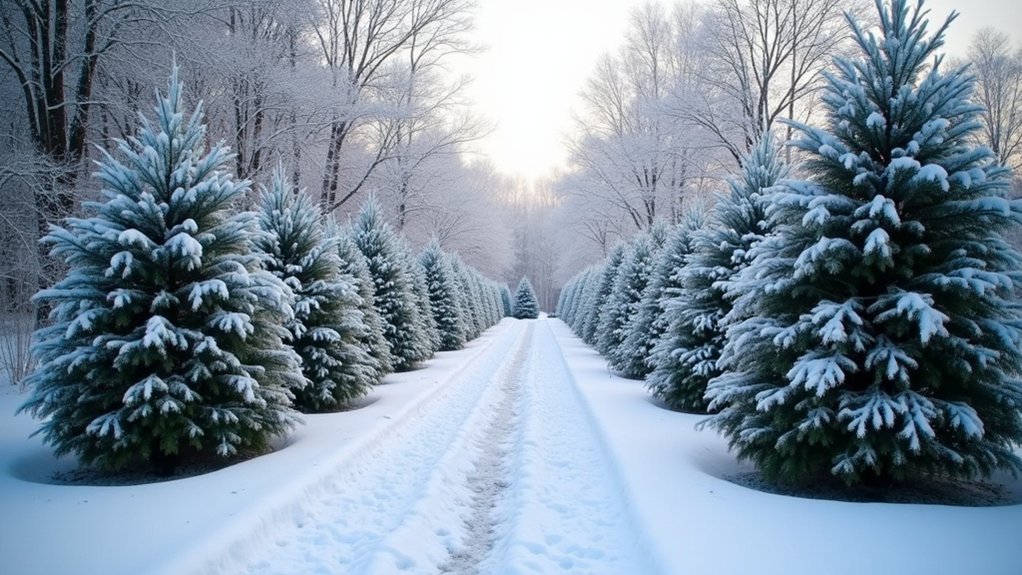
Canadian Hemlock hedges excel in snowy landscapes where other privacy options often falter under winter’s weight.
These resilient evergreens thrive in USDA zones 3-7, standing tall at 40-70 feet in their mature state with a natural pyramidal form that’s perfect for creating dense privacy barriers.
For your snowy climate property, Canadian Hemlock offers:
- Snow-shedding capability – Their soft, feathery foliage naturally releases heavy snow before branches break.
- Year-round privacy – Dense growth habit maintains screening even during heavy snowfall.
- Climate adaptability – Performs well in partial shade conditions common in winter months.
- Natural windbreak – Creates effective protection from harsh winter winds while maintaining an attractive appearance.
You’ll appreciate how these adaptable conifers maintain their privacy function while gracefully handling winter’s challenges.
Norway Spruce as a Windbreak and Snow Barrier
Among the most effective hedges for northern properties, Norway Spruce stands out as a powerhouse windbreak and snow barrier that thrives in harsh winter conditions.
When winter winds howl across northern landscapes, Norway Spruce stands sentinel, an unmatched defender against nature’s harshest elements.
Its conical shape and strong branches easily support heavy snow loads without breaking or deforming.
You’ll appreciate its impressive mature size, reaching 40-60 feet tall with a 25-30 foot spread, creating substantial privacy and protection.
The tree’s dense foliage effectively catches snow, preventing drifts across your landscape while blocking bitter winter winds.
What makes Norway Spruce particularly valuable is its fast growth rate of 1-2 feet annually, establishing your protective barrier quicker than many alternatives.
Hardy in USDA zones 3-7 and adaptable to various soil types including sandy and clay conditions, you’ll find this versatile evergreen thrives virtually anywhere in cold northern climates.
Maintaining Your Snow-Hardy Privacy Hedge Year-Round
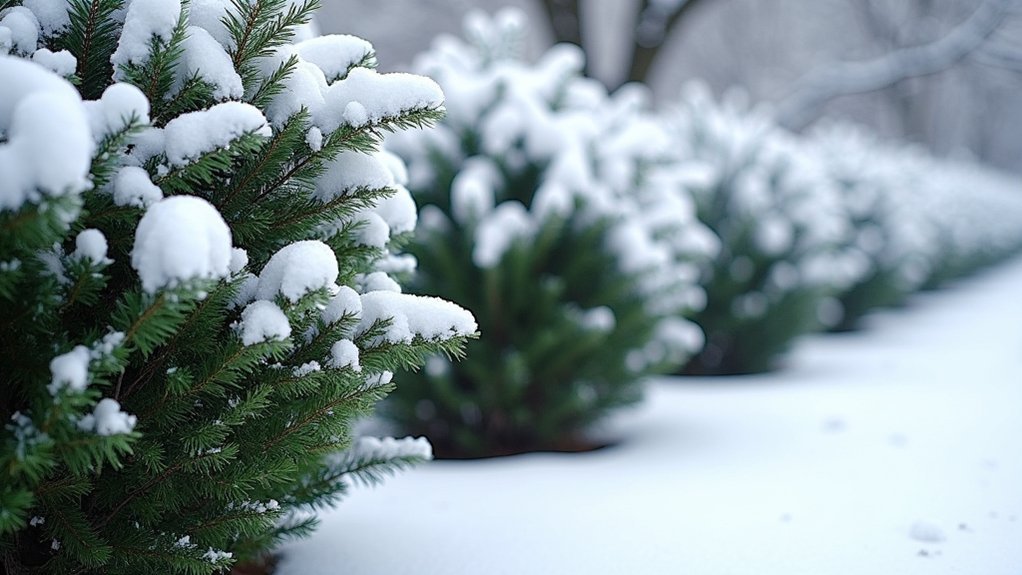
Keeping your privacy hedge healthy and functional throughout the year requires consistent attention, not just during winter months. Proper care guarantees your evergreen leaves stay vibrant and provide maximum privacy regardless of snowfall.
- Implement proper spacing when planting – allow 3-4 feet between plants to let snow filter through rather than accumulate heavily on branches.
- Regularly prune in late winter after snow seasons to remove damaged branches and shape for healthy spring growth.
- Prevent snow damage by gently brushing off heavy accumulations before branches bend or break.
- Support root health with a 2-3 inch layer of mulch around the base of your hedges, providing insulation during cold months while retaining essential moisture.
Monitor your hedges regularly for signs of stress or disease to maintain their privacy screening effectiveness year-round.
Frequently Asked Questions
What Plants Are Good for Privacy in Winter?
For winter privacy, you’ll want American Arborvitae, Green Mountain Boxwood, Blue Arrow Juniper, Mugo Pine, or Inkberry. These evergreens maintain dense foliage during cold months, providing year-round screening for your property.
What Is the Most Hardy Hedge?
The American Arborvitae is your most hardy hedge, withstanding temperatures down to -40°F in zones 3-7. You’ll also find Emerald Green Arborvitae and Wichita Blue Juniper remarkably resilient in cold climates.
Can Hedges Survive Winter?
Yes, many hedges can survive winter, especially evergreens like Arborvitae and Boxwood. You’ll find they maintain their foliage in cold climates, while deciduous varieties go dormant but return in spring.
What Is the Hardiest Shrub?
The hardiest shrub is the Emerald Green Arborvitae, which you’ll find thrives in temperatures down to USDA Zone 2. It’s exceptionally cold-resistant while maintaining its bright green foliage year-round despite harsh conditions.
In Summary
You’ve got excellent options for privacy hedges that won’t buckle under heavy snow. Choose arborvitae ‘Green Giant’, cold-hardy boxwoods, or sturdy junipers that shed snow naturally. Don’t forget American holly and upright yews for their rigid branches. Whatever you select, remember to prune properly in fall and gently brush off excessive snow accumulation to maintain your hedge’s health and structure for years to come.





Leave a Reply